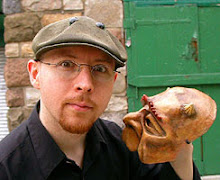I've been working in paper mache on a puppet head and three different masks, all made with wheat paste instead of my usual exterior wood glue.
The result already seems so much stronger than when using any version of PVA glue (white glue, wood glue, etc), and I only used three layers of paper (coffee filters sandwiching one layer of thin kraft paper) so far. The final result will require 6 to 8 layers.
A few weeks ago, I experimented with Corn starch, and I loved it except for the sagging caused by the re-wetting when assembling parts. This problem does not occur with wheat paste, at least not on the puppet I was assembling.
So, Wheat Paste has all the advantages I noticed in Corn starch, but none of the disadvantages!
Thanks go to
•Monica J. Roxburgh (GoblinArt) who years go, was writing about it.
•Mary Robinette Kowal, who wrote about wheat paste in her blog
•Jose Chavez, who posted a very useful video on how to make wheat paste.
Why use Wheat paste?
•Natural
•Non toxic
•Much much more economical
•Much stronger
•Better handling properties
•Strips stay flat when applied
•Dries faster than PVA glues
•Penetrates paper better than pva glue
•Bonds better with the paper.
VERY IMPORTANT TO SEAL
Pastes made from flours or starches are very rewettable! So it is very important to seal it properly before painting, otherwise you have high risks of warping from water, moisture in the air, spoilage, insect and pest attacks.
If you plan on using oil paints to finish your paper mache, you can seal with shellac, lacquers and other oil-compatible finishes.
If on the other hand, you will paint with acrylics or latex paints, you need to seal with a waterbased sealer.
As far as I know, the only true way to seal it perfectly is with oil based or lacquer products, and paint with oils. W.T. Benda, back in the 1930s, sealed his paper mache masks (glue he used is unknown to me, might have been wheat paste, or animal hide glue perhaps) with lacquer and painted them with oils. A colleague tried some Benda Masks a few years ago, and says they are good as new.
For my purposes and required times of delivery, waterbased products, which dry very fast, are what I have to use, until I can find natrual, non toxic alternatives that work even better.
Still, the current results are more than satisfactory, and extremely durable. Precautions have to be taken against the rain and excess moisture, but those have to be taken into consideration for all puppets and masks anyways.
My current sealer of choice is Weldbond, which is a different kind of PVA, and it does a very good job. It is a perfect stable ground for acrylic paints, contrary to all other PVA I tried before for the same purpose, which make acrylic paints crack (neat effect, but only if wanted). Still, I want to find a better option, a natural product I can make or find locally.
Help in finding it is much appreciated!
added:
HOW?
To seal with Weldbond 9and probably other PVA products), I first spray some rubbing alcohol onto the paper, and quickly paint the water-diluted Weldbond onto that area.
Since the Rubbing alcohol evaporates fast, it is necessary to add more as you move on to another area. Without this step, the first and sometimes second paper layers delaminate slightly, causing some annoying surface defects.



2 comments:
unfortunately the youtube link of the wheat paste is gone, can you describe what was in the video? thanks
I am also very curious in your recipe for Boiled Wheat Paste. As the above commentor mentioned, the youtube link is gone. Would love to get info on your recipe. Thanks!
Post a Comment